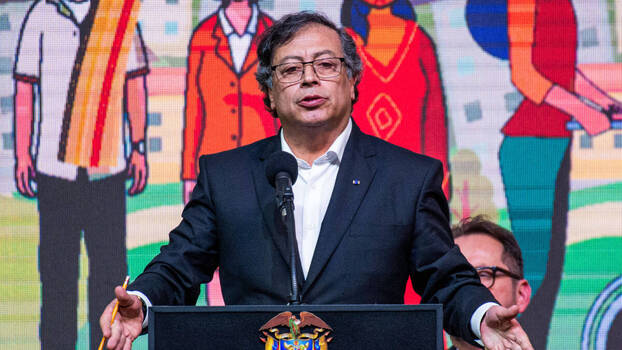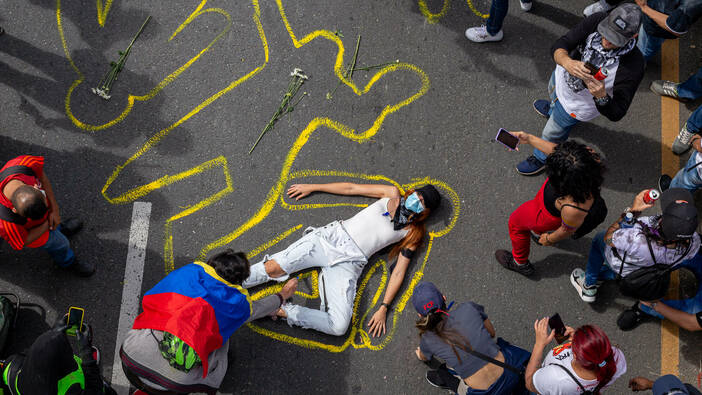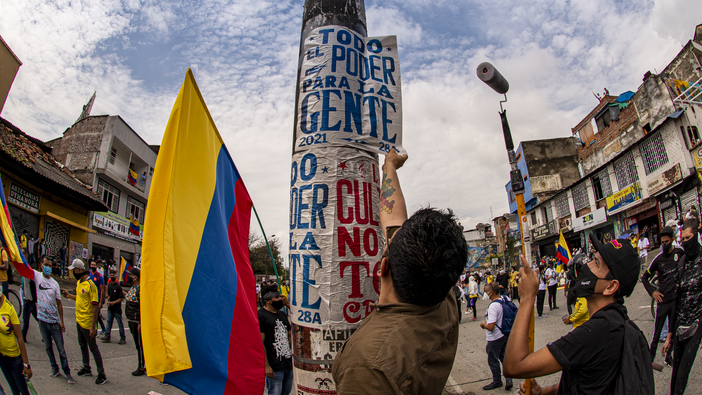
The triumph of the Left in the Colombian presidential election of August 2022 represented a major political upheaval. The 63-year-old Gustavo Petro, who served as mayor of Bogotá from 2012 to 2015, had been a member of the M19 guerrillas as a young man, whereas his 41-year-old, Afro-Colombian Vice-President Francia Márquez had since her youth struggled to make ends meet as a single mother, domestic worker, and even gold panner, and had organized resistance in her home community against the British-South African mining company AngloGold Ashanti. There could hardly have been a more radical shift in government. However, after one year of Petro’s administration, it has become clear that the presidential office alone is not enough to bring about the fundamental social and democratic reforms that Colombia needs.
Raul Zelik is a writer, journalist, translator, and political scientist. From 2016–2022, he was a member of the national leadership of Die Linke.
From an Uprising against Poverty to a Reform Agenda
The fact that the Petro-Márquez team was even able to win the presidential election against the right-wing populist candidate Rodolfo Hernández can only be understood when set against the backdrop of the massive anti-poverty protests that took place two years ago. In reaction to a planned tax reform, which the government of President Iván Duque (2018–22) intended to use in order to pass on the costs of the COVID-19 crisis to the lower classes, a broad coalition of social actors called for an indefinite nationwide strike in April 2021. Blockades and street riots left Colombia on tenterhooks for two months. Police killed close to a hundred people during the protests, and another hundred youths “disappeared” without a trace after having been arrested. The brutality of the repression resulted in a deep crisis of legitimacy for the political system and paved the way for Petro as a standard-bearer for the left-wing opposition.
Despite Petro’s election win being by a narrow margin of 700,000 votes, the result was uncontested. His campaign had focused on a major new peace initiative and social reforms to combat inequality (the Gini coefficient for wealth in Colombia is over 0.8). In addition, Petro’s Pacto Histórico (Historical Pact), as the left-wing alliance calls itself, has also taken up the causes of feminist, anti-racist, and ecological reforms. To that effect, Vice-President Márquez is heading the newly-founded Ministry of Equality, Petro committed himself to anti-patriarchal goals in the election campaign, and the environmental activist Irene Vélez has been given the role of Minister for Mines and Energy, who then announced a halt to the awarding of new concessions for oil and mining projects.
Although the left-wing government does face these financing problems, an even graver issue is that it is opposed by key factions who hold sway in the country. Business associations oppose the planned reforms to healthcare, pensions, and labour laws.
The latter in particular carries a major potential for conflict in Colombia. On the one hand, the struggle against extractivism (meaning the economic structure based on the plundering of natural resources) has been of pivotal importance for the Colombian Left in recent years — combining resistance against the displacement of the rural population with ecological and anti-imperialist demands. On the other hand, the export of raw materials is essential for the survival of the economy and the state: out of the total USD 57 billion that the country earned from exports in 2022, 32 billion came from raw material extraction. It is unclear how the Petro administration plans to finance the planned social spending and public investments without revenues from oil, coal, gold, and nickel. As a dependent economy, the Colombian state currently has to pay about eight percent interest on dollar-denominated loans on the international financial markets and is thus directly reliant on resource revenues to fund its budget.
Although the left-wing government does face these financing problems, an even graver issue is that it is opposed by key factions who hold sway in the country. Business associations oppose the planned reforms to healthcare, pensions, and labour laws. After 50 years of civil war, the army, police, and judiciary are firmly in the hands of the authoritarian right. And the three most powerful business families — Santo Domingo, Ardila Lülle, and Sarmiento Angulo — own large media conglomerates, which gives them the power to thwart any reform that goes against their interests. Not even Congress is reliably on the President’s side: Petro’s electoral alliance Pacto Histórico, made up of 20 small parties, accounts for less than a quarter of the deputies in the two chambers of the Colombian Congress.
The First Reforms and the Break-Up of the Government Coalition
As this balance of power was disadvantageous to the Left, President Petro, in the run-up to the election, tried to include some politicians from centre-right parties in his project and forged a surprisingly broad coalition after his victory. In fact, he managed to incorporate into this alliance not only the Liberal Party and the Conservative Party, but also the Union Party for the People of former President Juan Manuel Santos (2010–18). However, in exchange for stabilizing the new government, Petro had to submit to the clientelistic logic of the traditional parties and hand over lucrative ministries and administrative posts to the centre-right parties.
Nevertheless, the new government’s performance during the first few months was quite encouraging. Allies of the popular movements had taken important posts in government, including the Peace Commissioner Danilo Rueda, Defence Minister Iván Velásquez, Health Minister Carolina Corcho, and the aforementioned Minister for Mines and Energy Irene Vélez. Forty generals who had been accused of human rights violations were sent into retirement. Lastly, the planned tax reform was able to be passed in a watered-down version: since then, assets and dividends have been taxed somewhat more heavily than in the past.
The future of peace initiatives is also uncertain.
However, since the turn of the year, this cross-party cooperation is over. Opposition from Petro’s liberal and conservative allies was mainly ignited by the planned strengthening of the public health sector. In the 1990s, the Colombian health system was privatized at the behest of Álvaro Uribe, who later became president (2002–10) and is still considered the undisputed leader of the Colombian right. Since then, the state has paid health insurance contributions for lower income groups, but healthcare has become a lucrative business. As insurance companies can minimize their costs in this way, patients often have to take legal action in order to assert their rights to treatment. Consequently, industry profits are high. Six private health insurance companies are among the 35 largest companies in Colombia.
When his bourgeois allies first blocked the planned healthcare reform and then also the labour and pension reforms in the respective parliamentary committees, President Petro took drastic measures. He dismissed seven ministers and dissolved the coalition with the Liberals and Conservatives. While individuals from these parties are still in the government, Petro’s coalition no longer has a majority in Congress. It is doubtful that any of Petro’s ambitious social and environmental reforms can be passed by 2026.
“Comprehensive Peace” and Negotiations with the National Liberation Army
The future of peace initiatives is also uncertain. However, this primarily relates to the complex constellation of conflicts in the country. The demobilization of the FARC guerrillas in 2016 has not led to an end to the political violence but instead has further complicated the situation in many regions. Today, various FARC splinter groups are competing with paramilitary factions for control of territories and drug trafficking routes.
The disastrous failure of the peace process with the FARC can be attributed to three main causes. Firstly, important elements of the agreement were not implemented by President Santos’s successor, Iván Duque. Secondly, the social causes of the conflict — land distribution, inequality, and the willingness of the economic elites to use violence — were not taken into account because President Santos had declared social and economic policies “non-negotiable”. And thirdly, the process was a bilateral agreement between the government and the FARC, excluding both the population and the rank-and-file guerrillas from the negotiations.
While the Colombian oligarchy will continue to obstruct the social reforms that it has consistently thwarted over the past decades, the Left has a somewhat greater negotiating power within the framework of a peace process.
As a result, a significant number of FARC fighters have gone back to illegal activities. However, political motivations hardly play a role in their taking up arms any more. At least according to reports from farmer organizations, the Carlos Patino Front (also referred to as the “FARC dissidents”) are trying to stop the self-organization of farmers and Black and Indigenous communities, and in some areas, such as in the border region of Arauca Department, they function as an army-affiliated paramilitary organization. Against this background, it is not quite clear how the peace negotiations — initiated by the Petro government with the FARC dissidents and some organized crime groups — are expected to reach a conclusion.
The peace process with the National Liberation Army (ELN) is almost as complicated, but is much clearer in political terms. The Marxist guerrillas, who are influenced by liberation theology, have since July 2023 been party to a ceasefire, after some initial communication problems with the government. The negotiations conducted so far in Mexico, Cuba, and Venezuela differ in several respects from the peace process with the FARC. The ELN leadership is not seeking political posts, nor does it claim to represent society. Furthermore, the negotiation methodology is based on the assumption that the armed conflict in Colombia has social causes that need to be overcome in a comprehensive transformation process. Consequently, the talks do not centre on the demobilization and reintegration of the guerrillas. The main axis of the peace process is a social dialogue, which is to be organized by the Comité Nacional de Participación, an association of 81 civil society organizations, over the next two years. The aim is for this dialogue to form a framework for Colombian civil society in which they can develop a reform agenda. This agenda should encompass social, economic, and political aspects, and civil society should be invested in its successful implementation.
The goal is therefore to dismantle the social justification of the guerrillas’ cause through a process of transformation. While the Colombian oligarchy will continue to obstruct the social reforms that it has consistently thwarted over the past decades, the Left has a somewhat greater negotiating power within the framework of a peace process: as long as rural regions remain under the control of the ELN, which according to intelligence reports has grown from around 4000 to nearly 8000 fighters since the demobilization of the FARC, the country’s investment climate remains uncertain. Therefore, the segment of the Colombian upper class, which does not directly profit from war and displacement, might well be interested in supporting the peace process with the ELN.
To Enact Structural Change, the Interests of the Upper Class Must be Overcome
Whether the Petro government can regain the initiative is yet to be seen. The corruption scandal involving his son, Nicolás Petro, has further weakened the government, which has for months been under attack from major media conglomerates. During the opposition’s protest marches in recent months, it has become evident that the far-right, which has coalesced around the military and business class, can easily mobilize tens of thousands on the streets.
One thing is certain: in Colombia, structural change will only be possible if social movements can strive to overcome the interests of the upper class.
The left-wing government still has to its advantage that Colombia’s social movements, trade unions, and left-wing parties are under few illusions about their president’s ability to shape policy. In the spring of this year, ASOINCA — the teachers’ union in Cauca Department — occupied a parliamentary chamber as a means of pressuring representatives to implement the healthcare reform. Fernando Vargas, president of the union, justified this action by stating: “It is a bit paradoxical. Our demands align with President Petro’s proposals, but we fear that the super-rich in our country will see to it that the planned reform is scaled down beyond recognition”. Without a social mobilization that pushes the president forward, there will be no social reforms in Colombia.
This section of the grassroots movements has found encouragement in Petro’s attitude during the coalition crisis in April. Alfredo Burbano, head of the social research centre CEDINS, stated at the time that it was a positive sign that Petro had sacrificed the coalition rather than his reform agenda. Although this made his government even more vulnerable, at least now the balance of power was clear. One thing is certain: in Colombia, structural change will only be possible if social movements can strive to overcome the interests of the upper class.
Translated by Diego Otero and Rowan Coupland for Gegensatz Translation Collective.

